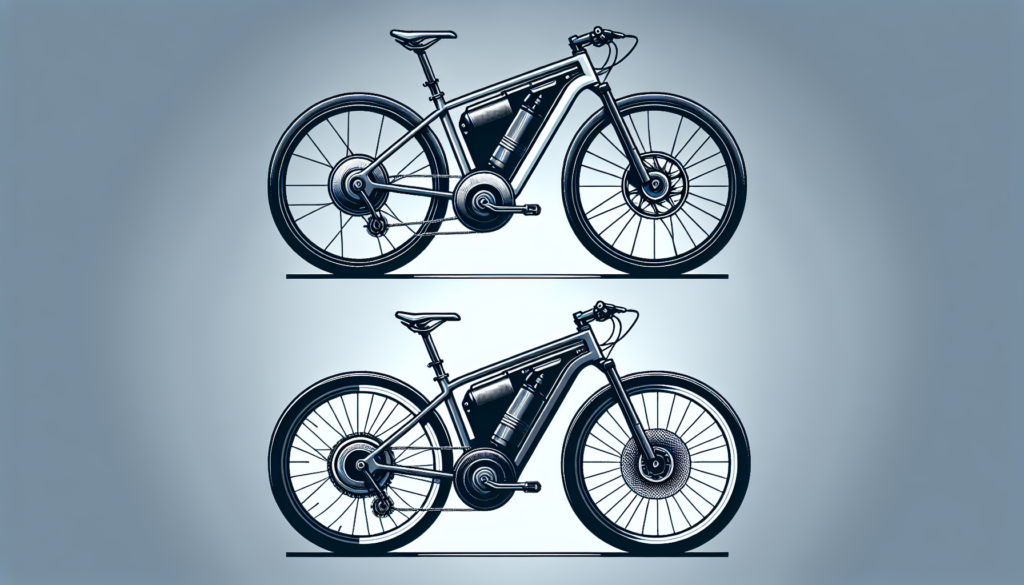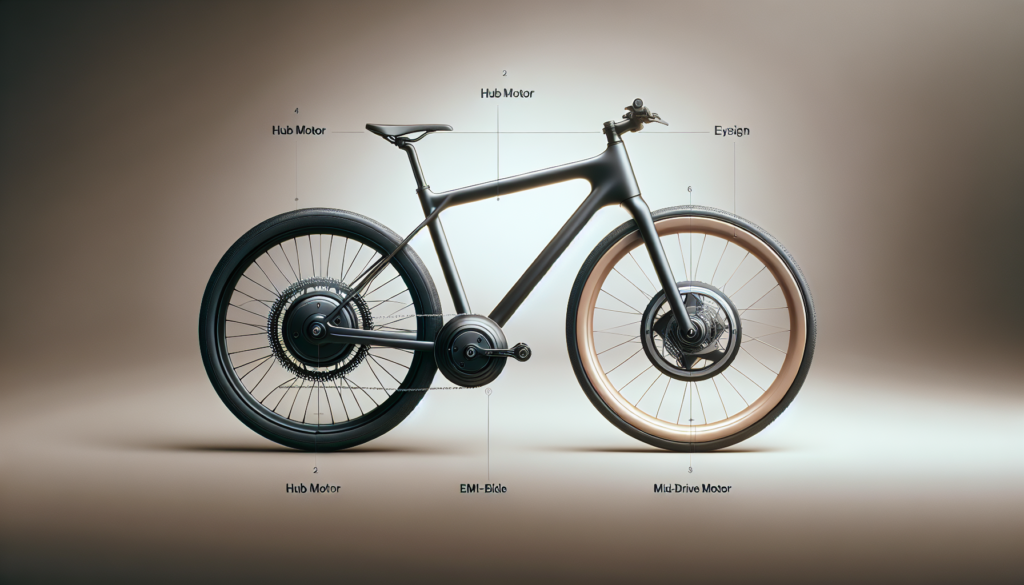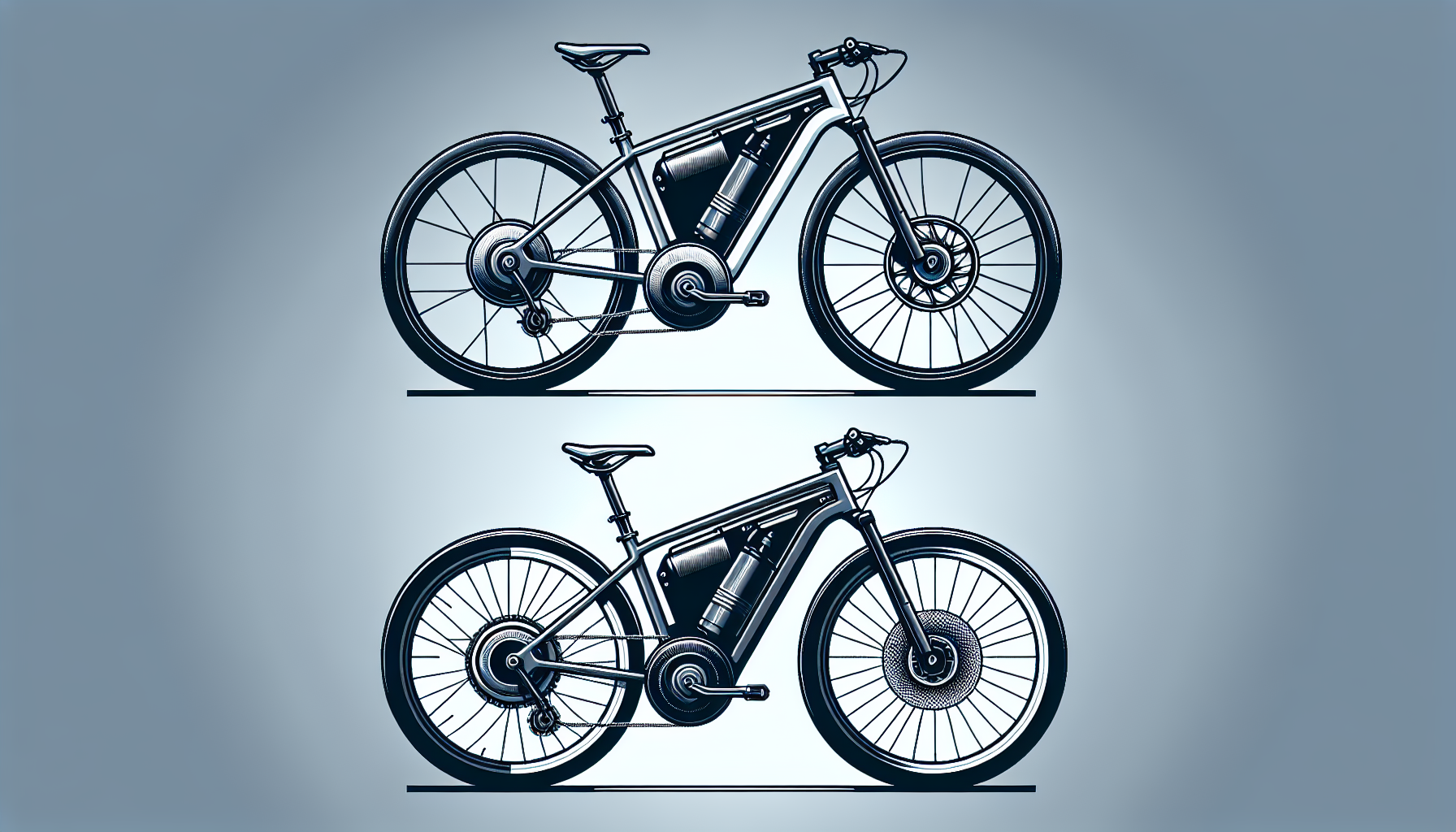Have you ever wondered about the key differences between hub motor and mid-drive motor e-bikes? With the growing popularity of electric bikes, it’s essential to understand the distinct advantages and characteristics of these two motor types. While hub motors provide a simpler design and easier maintenance, mid-drive motors offer better weight distribution and a more natural riding experience. In this article, we will explore the contrasting features of hub motor and mid-drive motor e-bikes, helping you make an informed decision when choosing your next electric ride.

Overview
When it comes to electric bikes (e-bikes), there are two main types of motors that you can choose from: hub motors and mid-drive motors. Each type has its own set of advantages and disadvantages, and understanding these differences is crucial in determining which motor will best suit your needs. In this article, we will explore the characteristics of both hub motors and mid-drive motors, highlighting their advantages, disadvantages, power and torque capabilities, weight distribution, efficiency, ride experience, terrain compatibility, and maintenance requirements. By the end of this comprehensive guide, you will have a clear understanding of which motor type is the right fit for you.
Hub Motor E-bikes
Direct Drive Hub Motor
One type of hub motor commonly found in e-bikes is the direct drive hub motor. As the name suggests, these motors have a direct drive system, meaning that the motor is directly connected to the bicycle’s wheel. Direct drive hub motors are typically larger and heavier than their geared counterparts, but they compensate for this with their simplistic design and robustness. With fewer moving parts, direct drive hub motors tend to be more reliable and require less maintenance.
Geared Hub Motor
The other type of hub motor frequently used in e-bikes is the geared hub motor. Unlike direct drive hub motors, geared hub motors feature an internal gearbox that allows for a higher torque and more power output. Geared hub motors are generally smaller and lighter compared to direct drive hub motors, making them a popular choice among e-bike manufacturers. However, the additional complexity of the gearbox does introduce a potential point of failure and may require more maintenance over time.
Advantages of Hub Motors
Hub motors, whether direct drive or geared, offer several advantages for e-bike riders. Firstly, they are simple and straightforward, making them easier to understand and maintain. Secondly, hub motors provide a smooth and quiet ride since the motor is located in the wheel and operates independently of the bicycle’s drivetrain. Thirdly, hub motors require minimal effort to start and propel the bike, allowing for effortless acceleration even on steep inclines. Finally, hub motors are less dependent on the rider’s pedaling power, making them a great choice for individuals who may have limited physical abilities or prefer a more relaxed riding experience.
Disadvantages of Hub Motors
While hub motors have their fair share of advantages, they also come with a few drawbacks. One notable disadvantage is the added weight in the wheel, which can affect the overall handling and maneuverability of the e-bike. Additionally, hub motors tend to have a higher rotational mass, meaning that they may be slower to respond and less nimble compared to mid-drive motors. Lastly, hub motors may struggle with steep hills or challenging off-road terrain, as the motor’s weight distribution in the wheel can impact traction and stability.
Mid-drive Motor E-bikes
Location
Unlike hub motors, which are located in the wheel itself, mid-drive motors are positioned near the bike’s bottom bracket, where the pedals and crankset are connected. This location allows the mid-drive motor to work in conjunction with the bike’s gears, taking full advantage of the existing drivetrain. By leveraging the gearing system, mid-drive motors can optimize power delivery, resulting in better climbing capabilities and overall performance.
Advantages of Mid-drive Motors
Mid-drive motors offer several benefits that set them apart from hub motors. Firstly, by utilizing the bike’s gears, mid-drive motors provide excellent torque and power, making them ideal for hilly terrain or off-road adventures. Secondly, with the motor positioned in the center of the bike, mid-drive motors offer superior weight distribution, leading to a more balanced and stable ride. Thirdly, mid-drive motors are generally more energy-efficient, as they can take advantage of the existing gear ratios to find the optimal power output for any given situation. Lastly, mid-drive motors allow for more significant customization, as they can be paired with various drivetrain components to meet specific riding preferences.
Disadvantages of Mid-drive Motors
Despite their numerous advantages, mid-drive motors also have some disadvantages to consider. One notable drawback is the increased complexity and maintenance requirements due to the interplay between the motor and the bike’s gears. This complexity can lead to a higher likelihood of mechanical issues and potentially more frequent maintenance intervals. Additionally, mid-drive motors can produce more noise and vibration since they are located near the rider’s feet. Lastly, mid-drive motors tend to be more expensive than hub motors, making them a less accessible option for budget-conscious riders.
Power and Torque
Hub Motor Power and Torque
When it comes to power and torque, hub motors offer a simple and consistent approach. Direct drive hub motors, with their direct connection to the wheel, provide a robust and reliable power output. However, this power output may be limited compared to mid-drive motors, especially when tackling steep inclines or off-road terrain. Geared hub motors make up for this limitation by utilizing an internal gearbox to increase torque and power delivery, offering better uphill performance.
Mid-drive Motor Power and Torque
Mid-drive motors excel in power and torque capabilities thanks to their ability to leverage the bike’s gears effectively. By working in conjunction with the drivetrain, mid-drive motors can provide immense torque, making them an excellent choice for riders who frequently encounter challenging terrain or enjoy off-road adventures. The ability to utilize the existing gear ratios allows mid-drive motors to deliver power more efficiently and effectively compared to hub motors.

Weight Distribution
Weight distribution plays a significant role in the overall handling and stability of an e-bike. Hub motors, with their location in the wheel, tend to have a less favorable weight distribution. The additional weight in the wheel can make the bike feel more front-heavy and affect maneuverability. On the other hand, mid-drive motors, positioned near the bottom bracket, offer a more balanced weight distribution. By locating the motor in the center of the bike, mid-drive motors ensure a more stable and nimble ride.
Efficiency
In terms of efficiency, mid-drive motors have the upper hand due to their ability to optimize power delivery through the bike’s gear ratios. By matching the motor’s output with the appropriate gear ratio, mid-drive motors can minimize energy wastage and maximize overall efficiency. Hub motors, while still efficient, may not be able to achieve the same level of energy optimization since they operate independently of the bike’s drivetrain.
Ride Experience
The ride experience offered by hub motors and mid-drive motors can vary significantly based on personal preferences and riding styles. Hub motors, with their autonomous operation, provide a smooth and effortless ride, requiring less effort from the rider. This makes them a popular choice for leisure riders or individuals who may have limited physical abilities. On the other hand, mid-drive motors offer a more dynamic and engaging ride, as the motor works in tandem with the bike’s gears. This synchronized power delivery allows for better control and responsiveness, making mid-drive motors a preferred option for avid cyclists or those seeking a more interactive riding experience.
Terrain
When it comes to tackling different types of terrain, both hub motors and mid-drive motors have their strengths and limitations. Hub motors, particularly geared hub motors, are well-suited for flat or moderately hilly terrain, offering effortless acceleration and continuous power delivery. However, when faced with steep inclines or challenging off-road paths, hub motors may struggle due to the weight distribution in the wheel affecting traction and stability. Mid-drive motors, on the other hand, excel in hilly and off-road terrain due to their superior torque and power capabilities. By leveraging the bike’s gears, mid-drive motors can conquer uneven surfaces with ease, providing the rider with optimal control and performance.
Maintenance
Maintenance requirements can vary between hub motors and mid-drive motors. Hub motors, particularly direct drive hub motors, tend to be more robust and require less maintenance. With fewer moving parts, there are fewer components that can fail or require adjustments. However, if maintenance is necessary, accessing the motor directly may prove to be more challenging and time-consuming. Geared hub motors may require more regular maintenance due to the complexity of the internal gearbox, which may require occasional lubrication or adjustment.
With mid-drive motors, there may be a higher likelihood of mechanical issues due to the interplay between the motor and the bike’s gears. Regular inspection and adjustment of the drivetrain, along with periodic maintenance of the motor, are essential to ensure optimal performance. However, the advantage of mid-drive motors is that they often utilize standard bike components, making it easier to find replacement parts or conduct repairs.
Conclusion
In summary, the choice between a hub motor and a mid-drive motor for your e-bike ultimately depends on your specific needs and preferences. Hub motors, whether direct drive or geared, offer simplicity, reliability, and an effortless ride experience. They are well-suited for leisurely rides on flat or moderately hilly terrain. On the other hand, mid-drive motors provide superior power and torque, optimal weight distribution, energy efficiency, and a more engaging ride. They are the preferred choice for riders who frequently encounter steep hills, enjoy off-road adventures, or desire a more dynamic riding experience. Consider factors such as terrain, desired ride experience, maintenance requirements, and budget when making your decision. With a clear understanding of the characteristics and trade-offs between hub motors and mid-drive motors, you can confidently select the motor type that will enhance your e-biking adventures.

